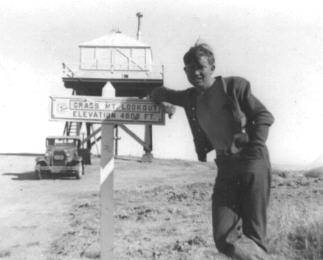
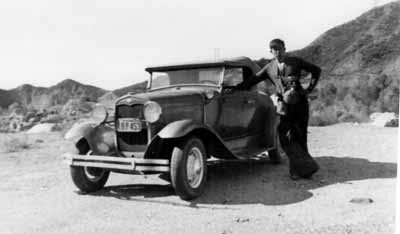
Bob with his sister's Model A
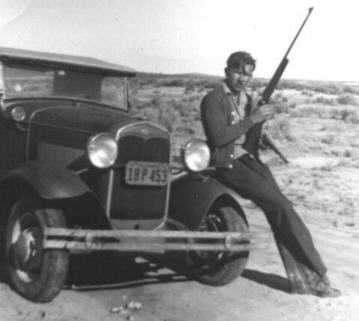
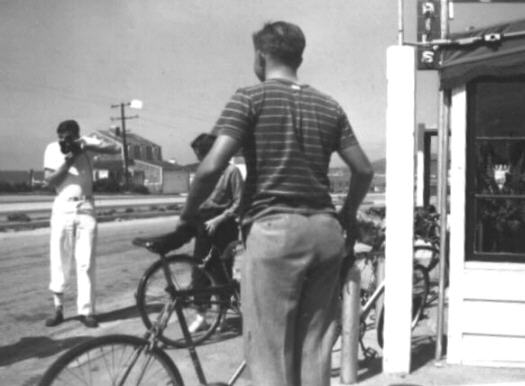
Chuck Dundore and Robert near the beach at Malibu, 1939
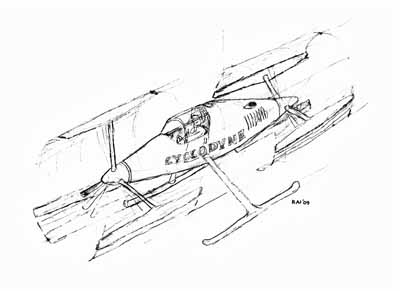
Bob drew this picture of the Cyclodyne from memory in early 2009

on San Clemente Island, photo by George Russon of the Canal Zone, circa 1939

San Clemente Island, photo by George Russon of the Canal Zone; Top-left is Banny Bankemper of Lousville KY; top-right is George R., Lower-right: Robert
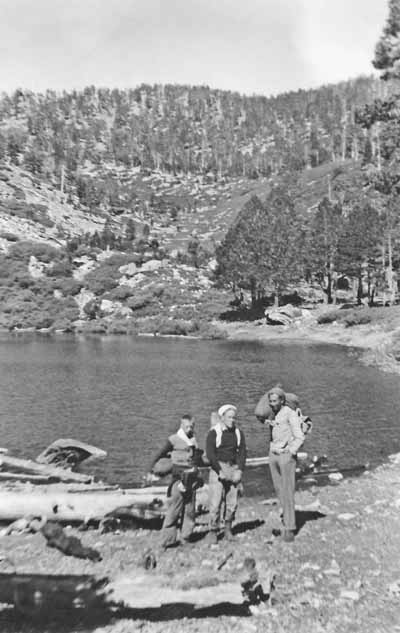
Richard Rydeen (Alstrup), Donald Rydeen(Alstrup), Bob at Dollar Lake, San Gorgonio Primitive Area, San Bernardino National Forest California 1939
| Bob recalls:
I often think of lost friends. At Fremont High School in ’39 the California National Guard had a program where students could attend a weekly evening one-hour meeting and get paid $30 per month. My neighbors and classmates, Bob and Bill Wilson tried to interest me in this easy money, but I had read Dalton Trumbo’s WW1 novel, Johnny got his gun and that book scared me to abhor the threat of being cannon fodder.
During the Fall of ’41, I went to Exposition Park and sat with Bill and Bob where the 160th Infantry was assembled. The boys were sleeping that night in pup tents waiting for transportation to the Philippine Islands. In this visit I wished them well but said nothing about my resolve to avoid being cannon fodder. About 4 months later we got the word that Mac Arthur had surrendered the 160th to the Japanese, affirming my resolution to keep out of it.
Bob also recalls:
I rode with Tim up through Lone Pine , parking his Ford at Whitney Portal and carrying our sleeping bags only as far as Consultation Lake, waking early the next morning,traveling light with a sausage,apples and canteens up the switchbacking trail scratching footholds with our sticks on many patches of icy snow.At one point we were passed by a man leading a heavily packed burro and a few minutes later, saw the burro slip on the ice and slide down the snowbank, flailing his hooves rolling to fortunately stop a short distance below us and the man running past us to unpack the load so the unhurt animal could get up.
Farther on this 6000 foot ascent we came out of the shadows and had less trouble. At the highest point in the continental USA we were prepared to leave our mark.Tim had brought a small can of red enamel and brush. Our names and date are on a rock perilously facing the enormous drop-off, out of sight to all except fools like us. Sometimes I wonder if that red enamel has withstood 70 years of granite spalling frost. That night, on our way back to LA, we stopped, when passing a car stopped with smoke coming from its engine. Tim, always prepared, asked the ladies helplessly watching their car burn, "can I use my fire extinguisher on it?" With his CO2 he had the fire out immediately, and with his Crescent Wrench, quickly had a gas line tightened, and their car started. We arrived back in Tujunga about 2 AM.
THE CYCLODYNE
In 1939, as a result of my injury working as a pile-driver-man, I decided to seek less dangerous work and enrolled in the aircraft drafting course at Frank Wiggins Trade School in Los Angeles. My teacher was Dave Cook and he recruited me to help him, for car fare, on his private invention called "Cyclodyne".
Dave was a retired Navy pilot who had worked on the "P-38" project at the Lockheed "Skunk works". The Cyclodyne was to be a high speed hovercraft. Dave was aware that the Sikorski-type helicopter had a speed limit, because the rotating radial wings in that type helicopter, when moving forward, had a problem with the wingtips when, in the advancing segment of their rotation were moving faster through the air than in the retreating segment. When the wing tip-speed approached the speed of sound, energy was diverted in a "sonic boom", and thus, faster speeds till involved this speed limit for Sikorski type helicopters.
Dave's hovercraft did not involve this problem. His craft consisted of rotary wings that rotated on hubs, axes aligned in the direction of travel so that the ends of the wing blades are always presented to the overtaken air. The lift vector moves seriously toward the advancing tips. Most helicopters are propelled forward by a force vector derived from the relation between the craft weight vector and the craft lift vector. The forward force vector is resisted by the drag force of the forward moving craft, gliding forward.
With the Cyclodyne, the rotating wing system drag is independent of the forward speed of the craft. Mechanical and strength of material problems, meanwhile have delayed Cyclodyne development for 70 years, if not the demise of most people concerned.
The proposed Cyclodyne consisted of 6 wings conformed on two contrarotating hubs arranged in the form seen on the McCormick-Deering wheat harvesting machines, wings spanwise are parallel to hub axes.
A gasoline-engine-powered, inertia-controlled transmission was to divide torque to the two rotating hubs to balance their lift vectors. Each wing was to be mounted centered on a radial strut extending from its hub. The cylindrical shaped path of each wing differentiated, along the wing's path, the lift vector by means of a sliding-rotatable cam located inside each hub.
The surface of this cam was to be profiled circumferentially and laterally, so that a spring-loaded tappet connected to a wrist pin behind the strut-wing hinge would regulate various angles of attack at each point along the wing's cylindrical path.
This cam, sliding and rotating with respect to the driveshaft provided the control for decreasing forehub's lift with respect to the aft hub's lift enabling gliding and the control for turning or rotating the craft.
Control of the 2 cams by the pilot's joystick was to be, by a rule ..... forward or aft motion of the stick results in forward or aft motion of the craft. Sideward motion of the stick results in rotating or turning the craft in that direction. Motion of the slide collar at the top of the stick results in unbalancing the power required to hover enabling similar craft motion up or down.
One of my contributions to the experiment was to borrow my mother' s sewing machine motor and variable speed foot pedal control to power a test stand for the first Cyclodyne rotor. After a few weeks, my mother insisted that I get her machine working again, which I did. A few weeks later I was inducted into the Sea Bees, where I resumed the duty of a Pile Driver Man in the Pacific Theater.
About 1960, quite by chance, I met Dave Cook Who said he was still trying to fund development of the Cyclodyne. When he learned that I was no longer in aviation, he commented, "What a waste of talent". The word Cyclodyne is apparently now the masthead property of a manufacturer of air conditioning equipment.
RAJ
DON and JIM RYDEEN (ALSTRUP)
Don and Jim were born Alstrup Their mother married Rydeen then divorced again. Confusion! Don and Bob were colleagues in the "News Delivery" business.
Bob recalls an "accident" where, while hunting rabbits with a 12 ga. shotgun, he discharged the gun into a cow patty. The angle of incidence of the splatter onto Don's back equalled the angle of incidence of the shot hitting the cow patty.
Don got revenge by disgorging chewed up cheez-its into an orange soda the 2 were sharing.
Dick Rydeen, in 1948, may have been associated with the break-up of the marriage of Jim Frank and Virginia(Ruth's sister -- Ruth is a future Mrs. Bob) by no fault of his own.
Although Don was a deepwater Signalman, his 3 years on Attu were boringly spent winter & summer occupying. His principal complaint was "it was so cold, his dick couldn't reach out to pee through all that thick clothing".
Incidentally, regarding Bob's stories:
Kvammen said "Don't ask Johnson expecting a simple answer, he'll give you a dissertation every time!"
Bob recalls:
My sister Marian was envied seriously by unemployed me (15 months older) when the week after her high school graduation she got a job as a telephone operator. She worked a split shift 7 days a week, 6AM till 10, then 2PM till 6PM.
Soon she was rolling in money, had a Model “A” Ford ragtop while I was walking the city for job interviews. Marian’s chum, Florence Lundeen had a job as a dancing girl in the Paramount Theater Vaudeville Show. Marian got a job there alongside Flossy rehearsing during her 10AM till 2PM break, then doing the introductory Can Can kick on the stage-wide chorus line at 9PM 7 days a week. I got back stage to smell those girls! Marian also went to a Modeling School and was walking around our house with a Phonebook balanced on her head. Several years later, I was browsing around a downtown LA shop that sold oddball things during my lunch hour and there was this table filled with thousands of little plastic tubes that you hold up to your eye and see semi-nude women posing and after studying a few of these tubes, there was Marian, bare breasted! I went through the whole pile to save my sister’s reputation and walked out with 17 tubes that I surreptitiously handed over to Marian at the first opportunity.
About this time, Bob also recalls:
Tim and I decided one fall weekend to drive my ’31 Model “A” Ford ragtop coupe down to see the Gulf of Baja. About forty miles south of Mexicali, the dust on the road was so thin and deep that it got into the clutch and abraded the throw-out bearing, so that the clutch pedal would no longer permit us to get the car out of high gear. Stopping meant killing the engine. We made a “U” turn back to LA and kept moving until we came to a gas station, stopping and killing the engine in front of the pump. After filling up, we together pushed the car and it started the engine and we jumped in and drove north. In the late afternoon we were getting hungry so we stopped the car facing downhill in front of a fruit stand in Julian. We had been sweating in Baja and were both drippy-muddy from that dust. When the lady at the fruit stand saw us, she said…”We don’t need any pickers today”. We bought 10 pounds of the most delicious tasting apricots that I can recall and started the car by helping it to roll downhill. Twas about 4AM Sunday morning when we went slowly through several red lighted and stop=signed intersections to arrive home, only stopping the car twice between Baja and LA.
Bob recalls:
After being fired by Bert Smith about March 1939, I enrolled in an aircraft drafting class at Frank Wiggins Trade School, L. A. City School District in Downtown Los Angeles. Many of my mates from my drafting class graduating frOm Fremont Hi in ’38 were already employed as draftsmen at the booming local aircraft manufacturing companies, earning about 4 times what Smith had paid me, jobs that were not at all hazardous.
My Wiggins aircraft drafting class teachers were Theodore Woolsey, who had worked for Douglas as part of the company’s staff that supported the US Army’s ’24 Around-the-world flight, and David Cook, a retired US Navy Annapolis graduate carrier aircraft pilot with the experience of being a project engineer on Lockheed’s P-38 project.
While attending these aircraft drafting classes, Cook recruited some of us to voluntarily work on his private invention, a supersonic hovercraft idea that he called the Cyclodyne. In June ’39, Woolsey joined a start-up enterprise called Interstate Aircraft as their chief engineer, partnering with C. C. Smith, scion of the Smith Oil Tool Company, recruiting those members of our class of aircraft drafting students who would work for a pittance and travel to Interstate’s startup factory on Imperial Highway in El Segundo. I suffered through some austerity with these apprenticeship opportunities which gave us all, at least, the pleasure of some productive accomplishments. In November ’39, I was hired as a tracer, the entry level position of the Douglas Aircraft Company Engineering Department at Santa Monica, The tracer traces from pencil drawings onto linen cloth using pens and india ink, all atop an illuminated glasstop drawing table.
My supervisor, Bob Roof, noticing that my habit of starting the ink flow in my crow-quill pen on a test cloth produced credible illustrations, advanced me to the position of illustrator and I was placed under the supervision of Oliver Chayie, a technical writer with the assignment of compiling the Operating and Maintenance Instruction Manual for the Secret XB-19 project. Anyone with hobby and working experience with do-it-yourself automobile maintenance, home workshop, model building aircraft, and such, is better fitted for understanding, describing , illustrating and explaining how to do things than the others whose experiences have been confined to the other specialties of earning a living. I was enthusiastic about my work on the XB-19 opportunity.
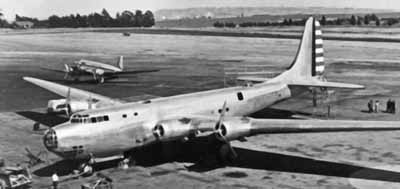
XB-19 after completion
The XB-19 was the world’s largest airplane at that time. The design included many never before attempted structures and systems, The project had been conceived in 1936 when the Russians had flown their experimental bomber unannounced from Moscow to March Field, California. When the XB-19 was test flown in 1943, offensive attack airplane technology had rendered the 1936 goals for long range bombing planes insufficient, and the only value that the XB-19 had was as a preliminary design for the various fleets of the smaller aircraft which won WWII. The XB-19 was junked after the war. One of its 8 foot diameter wheels is displayed at the Air force’s Museum at Wright Field, Ohio . I worked 80 hour weeks until July, 1943 when the grandmother of my neighbor who had been serving on Navy submarines since 1942, asked me ‘Why aren’t you out there fighting?’ I ended my aircraft career when I enlisted in the Navy in September 1943.
|


